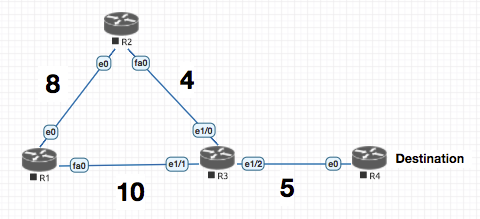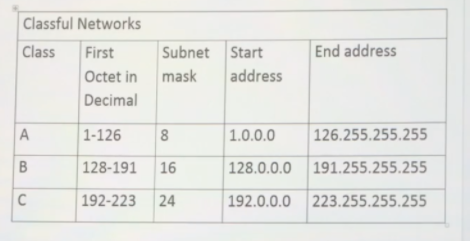EIGRP Tech Notes
by Vikas Srivastava
Opinions expressed are solely my own and do not express the views or opinions of my employer.
- About EIGRP
- Path Selection
- Loop Free Logic
- Successor / Feasible Successor Selection
- Load Balancing
- Auto Summarisation
- Passive Interface
- Stub Router
Link State Protocol : Link State knows every thing about the network. Distance Vector Protocol : Distance Vector is what the neighbor router has told it.
RIP is a true distance vector routing protocol and very simple: - No neighbor discovery.
Compare this with Hello Packets- Periodic updates. - Vulnerable to loops.Compare it with EIGRPs loop free logic- Simple metric (hop count).Compare it with EIGRP K Values
Cisco added some of the features from link-state routing protocols to EIGRP which makes it far more advanced than a true distance vector routing protocol like RIP. This is why (probably the marketing department) calls EIGRP an advanced distance vector or hybrid routing protocol.
- EIGRP does not use broadcast packets to send information to other neighbors but will use multicast or unicast.
- Besides IPv4 you can also use EIGRP to route IPv6 or even some older network layer protocols like IPX or AppleTalk.
- EIGRP is 100% loop-free and I’m going to show you why this is true.
About EIGRP
EIGRP Protocol Number is 88, EIGRP runs directly on top of the IP header. If you look at the picture above you see we have a frame header (for example an Ethernet Frame), an IP Header (we are using IPv4) and inside the IP packet you’ll find EIGRP.
EIGRP uses RTP (Reliable Transport Protocol) and its function is to deliver EIGRP packets between neighbors in a reliable and ordered way. Reliability means that there is acknowledgement for an operation , which makes it a reliable protocol.
EIGRP has 3 tables :
Neighbor Table Topology Table Global Routing Table
Hello packets are not acknowledged since the EIGRP used a holdown time. It can use Multicast or Unicast for the same . Since sending “individual” hellos to each of the routers, hence multicast is more efficient.
Different types of EIGRP Packets:
-
Hello: These are used for neighbor discovery. -
Updates: Updates are for sending routing information updates . -
Query: When the router has lost information on a certain network and does not have a back path , it send the query request. -
Reply: Reply packets are used in response to the query packets and are reliable. -
ACK: Acknowledgment
Path Selection

Advertised Distance : Is what your neigbor told you the cost to the distance is.
Feasible Distance : Is what your neigbor told you plus the cost to reach the neighbor .
So in the above example , R3 tells R2 that the cost to go to destination is 5 (Advertised Distance) but R2 knows that the Feasible Distance is 5 + 4 (Actual Distance)
Please note that on Only
SUCCESSORis added to the route table.
Loop Free Logic

Since
R3toldR2about the destination,R2will not advertise on the same link back toR3about its path to destination. Split Horizon
Note: Considerig the cost to Reach destination from R4 is 1
In the example above , we have the DESTINATION connection to the R4 router.
We are looking the topology from router R3’s perspective.
| Router | Advertised Distance | Feasible Distance |
|---|---|---|
| R4 | 1 | 6 (5+1) SUCCESSOR |
| R2 | 24 (8+10+5+1) |
28 (24+4) |
| R1 | 18 (8+4+5+1) |
28 (18+10) |
In the example above , Advertised Distance is what other routers have told R3 , Feasible Distance is what it takes R3 to reach other routers.
Successor / Feasible Successor Selection
The path with the lowest FD will be selected as the
Successor
For Feasible Successor to be selected the following criteria should be fullfilled:
Advertised Distance of Feasible Sucessor < Feasible Distance of Successor`
In the table above neither R1 nor R2 satisfied that criteria hence are not selected as the backup paths Feasible Sucessor
Load Balancing
Lets take an example of the following EIGRP routing table :
| Router | Advertised Distance | Feasible Distance | Sucessor |
|---|---|---|---|
| R1 | 10 | 15 | |
| R2 | 5 | 10 | SUCCESSOR |
| R3 | 9 | 109 | FEASIBLE SUCCESSOR |
In the above example , since R2 has lowest FD it becomes the Feasible Successor.
Now the question to ask for Feasible Successor Selection is :
Is my
Advertised Distanceless than theFDof Successor ?
Since in the above table 9 is less than FD 10 , it is selected as the FS.
Note that even though
R3has a highher FD of109, it is selected over theR1which is just15This is by design since at the heart EIGRP is a distance vector protocol.
Now coming back to load balancing
In the table above
In order to be able to do Load Balancing to the FS, the FD (total distance) should be less than
SUCCESSOR x MULTIPLIER
So in the above example , the let say the variance is set to 2 which means :
- Successor
10 x 2 = 20which is < than109; So no load balancing. -
Again , changing the successor to
4: Successor10 x4 = 40which is < than109. So no load balancing. - Finally :
Successor
10 x10 = 100which is > than109. So Load balancing happens now .
Auto Summarisation

With Auto Summarization, any network configured on the routers is summarised back to the subnet mask they fall under as per the above table .

So in the example above , the 172.16.0.0 will be advertised by default to Hearts and he wouldnt know where to send the packets. no auto-summary under the EIGRP process will eleviate this issue.
Passive Interface
So what do you have to do when you want to advertise a network without sending EIGRP packets on the interface and forming EIGRP neighbors? Use the passive interface command.
R2#show ip eigrp neighbors
EIGRP-IPv4 Neighbors for AS(100)
H Address Interface Hold Uptime SRTT RTO Q Seq
(sec) (ms) Cnt Num
0 192.168.1.1 Et1/2 7 00:00:09 23 138 0 2
R2#
In the above table :
Hold : The Holddown timer
SRTT : Smooth Round Trip Time , milliseconds it takes to send an eigrp packet and receive an ack.
R2#show ip eigrp topology
EIGRP-IPv4 Topology Table for AS(100)/ID(11.11.11.11)
Codes: P - Passive, A - Active, U - Update, Q - Query, R - Reply,
r - reply Status, s - sia Status
P 11.11.11.11/32, 1 successors, FD is 128256
via Connected, Loopback3
P 10.0.0.0/24, 1 successors, FD is 409600
via 192.168.1.1 (409600/128256), Ethernet1/2
P 192.168.1.0/30, 1 successors, FD is 281600
via Connected, Ethernet1/2
P 10.0.0.1/32, 1 successors, FD is 128256
via Connected, Loopback0
PASSIVE : Means that I have the route and I am no longer looking for it .
Active Active is not good since it means we have lost information about a certain network and EIGRP doesn’t know another way of reaching this network.
SIA Stuck in Active : Its BAD , it means that EIGRP has not reveived a reply to a query .
(409600/128256) : FD/AD
Ethernet1/2 : Is the interface we are using to send our packets in order to reach this network.
Keep in mind that the AS Numbers have to match to form neighborship
EIGRP Metrics
EIGRP Metric = 256*((K1*Bw) + (K2*Bw)/(256-Load) + K3*Delay)*(K5/(Reliability + K4)))
Don’t worry it is not used as is . The values of interest are K1,K2 ,K3,K4,K5
- Bandwidth (
K1) - Load (
K2) - Delay (
K3) - Reliability (
K4) - MTU (
K5)
The K1,K2 etc values are not mapped to correspoding data , for example K1 is not 1:1 mapped with the bandwidth. The K values are only numbers to scale numbers
R2#show ip protocols
*** IP Routing is NSF aware ***
Routing Protocol is "eigrp 100"
Outgoing update filter list for all interfaces is not set
Incoming update filter list for all interfaces is not set
Default networks flagged in outgoing updates
Default networks accepted from incoming updates
EIGRP-IPv4 Protocol for AS(100)
Metric weight K1=1, K2=0, K3=1, K4=0, K5=0
NSF-aware route hold timer is 240
Router-ID: 11.11.11.11
Topology : 0 (base)
Active Timer: 3 min
Distance: internal 90 external 170
Maximum path: 4
Maximum hopcount 100
Maximum metric variance 1
Automatic Summarization: disabled
Maximum path: 4
Routing for Networks:
11.11.11.11/32
0.0.0.0
Routing Information Sources:
Gateway Distance Last Update
192.168.1.1 90 00:10:03
Distance: internal 90 external 170
By default only K1 and K3 are enabled and we don’t use K2 or K4. This means that only bandwidth and delay are used in the formula.
Why not? Because loading and reliability are dynamic values and they can change over time. You don’t want your EIGRP routers calculating 24/7 and sending updates
Bandwidth (K1)
R2#show interfaces e1/2 | inc BW
MTU 1500 bytes, BW 10000 Kbit/sec, DLY 1000 usec,
You can tweak it using the bandwith command for the interface.
Load (K2)
R2#show interfaces e1/2 | inc load
reliability 255/255, txload 1/255, rxload 1/255
Delay (K3)
R2#show interfaces e1/2 | inc DLY
MTU 1500 bytes, BW 10000 Kbit/sec, DLY 1000 usec,
Can be tweaked by delay command at the interface level
Reliability (K4)
R2#show interfaces e1/2 | inc relia
reliability 255/255, txload 1/255, rxload 1/255
Reliability at 255/255 is 100%. This means that you don’t have issues on the physical or data-link layer.
MTU (K5)
R2#show interfaces e1/2 | inc MTU
MTU 1500 bytes, BW 10000 Kbit/sec, DLY 1000 usec,
Since only K1 and K3 are enabled we can simplify the EIGRP formula:
> Metric = bandwidth (slowest link) + delay (sum of delays)
Which further expands to:
> Metric = (107 / slowest link bandwidth) * 256 + (sum of delays of the path) * 256
The metrics in EIGRP are a pain to work with since the values are so LARGE! If you want to practice with EIGRP you can try to disable all the K-values except K3. This will make EIGRP only use delay as metric.
Good Documentation on EIGRP Metric Calculation
https://www.cisco.com/c/en/us/products/collateral/ios-nx-os-software/enhanced-interior-gateway-routing-protocol-eigrp/whitepaper_C11-720525.html
EIGRP Scalability Issues
EIGRP is designed for large enterprise networks but having one big EIGRP network (5000+ prefixes and many hops) can lead to some problems:
- Lots of EIGRP prefixes equal a large topology table and routing table.
- Calculating the successor router will take longer if you have many EIGRP neighbors and different paths.
- If there are many backup paths EIGRP will have to see if there are 1 or more feasible successors, this will take longer.
- More information means our EIGRP routers have to work harder to process everything.
- When EIGRP loses a route and there is no feasible successor the route will go from passive to active and the router starts sending queries to its neighbors.
- EIGRP sends queries on all interfaces except the interface of the successor.
Stub Router
An EIGRP router that is configured as a stub does not receive queries when one of its neighbors loses a network.

In the above example when you make Jack the stub router , when lo0 (2.2.2.0) goes down it will send out a QUERY
But John will not send any query to Jack because it knows that it is a Stub router .
When we say a switch is a Stub EIGRP Switch , it means that the Switch will learn the information about others in the network , but no it will not be able to advertise what it knows as John will not be able to send
QUERYto it .
How to see if a router is Stub or not
In the example below , it means that the stub is Adverstising CONNECTED SUMMARY routes
EIGRP-IPv4 Neighbors for AS(100)
H Address Interface Hold Uptime SRTT RTO Q Seq
(sec) (ms) Cnt Num
0 192.168.1.1 Et1/2 10 00:06:33 16 100 0 5
Version 11.0/2.0, Retrans: 0, Retries: 0, Prefixes: 1
Topology-ids from peer - 0
Stub Peer Advertising (CONNECTED SUMMARY ) Routes
Suppressing queries
In the example below , it means that the stub is a receive only neighbour
EIGRP-IPv4 Neighbors for AS(100)
H Address Interface Hold Uptime SRTT RTO Q Seq
(sec) (ms) Cnt Num
0 192.168.1.1 Et1/2 14 00:00:27 12 100 0 10
Version 11.0/2.0, Retrans: 0, Retries: 0
Topology-ids from peer - 0
Receive-Only Peer Advertising (No) Routes
Suppressing queries
So basically , you can be learning routes from the network as an update , but NO one will ask you (The Stub) for routes.
Different types of Stub Options
R1(config-router)#eigrp stub ?
connected Do advertise connected routes
leak-map Allow dynamic prefixes based on the leak-map
receive-only Set receive only neighbor
redistributed Do advertise redistributed routes
static Do advertise static routes
summary Do advertise summary routes
<cr>
Name EIGRP Instance Example
R1(config)#router eigrp HELLO_WORLD
R1(config-router)#address-family ipv4 autonomous-system 333
R1(config-router-af)#network 2.2.2.2 0.0.0.0
R1(config-router-af)#
R2#debug eigrp packets ?
SIAquery EIGRP SIA-Query packets
SIAreply EIGRP SIA-Reply packets
ack EIGRP ack packets
all Display all EIGRP packets
hello EIGRP hello packets
query EIGRP query packets
reply EIGRP reply packets
request EIGRP request packets
retry EIGRP retransmissions
stub EIGRP stub packets
terse Display all EIGRP packets except Hellos
update EIGRP update packets
<cr>
R2#clear ip eigrp neighbors
R2#
Show up eigrp neighbours
Show ip protocol
R2#show ip protocols
*** IP Routing is NSF aware ***
Routing Protocol is "eigrp 100"
Outgoing update filter list for all interfaces is not set
Incoming update filter list for all interfaces is not set
Default networks flagged in outgoing updates
Default networks accepted from incoming updates
EIGRP-IPv4 Protocol for AS(100)
Metric weight K1=1, K2=0, K3=1, K4=0, K5=0
NSF-aware route hold timer is 240
Router-ID: 11.11.11.11
Topology : 0 (base)
Active Timer: 3 min
Distance: internal 90 external 170
Maximum path: 4
Maximum hopcount 100
Maximum metric variance 1
Automatic Summarization: disabled
Maximum path: 4
Routing for Networks:
11.11.11.11/32
0.0.0.0
Routing Information Sources:
Gateway Distance Last Update
Distance: internal 90 external 170
R2#show ip eigrp topology
EIGRP-IPv4 Topology Table for AS(100)/ID(11.11.11.11)
Codes: P - Passive, A - Active, U - Update, Q - Query, R - Reply,
r - reply Status, s - sia Status
P 11.11.11.11/32, 1 successors, FD is 128256
via Connected, Loopback3
P 10.0.0.0/24, 1 successors, FD is 409600
via 192.168.1.1 (409600/128256), Ethernet1/2
P 192.168.1.0/30, 1 successors, FD is 281600
via Connected, Ethernet1/2
P 10.0.0.1/32, 1 successors, FD is 128256
via Connected, Loopback0
R2#
How to Debug Interesting Packet :
Jack(config)# access-list 100 permit ip any 192.168.200.20 0.0.0.0
Jack(config)#exit
Jack# debug ip packet 100
IP packet debugging is on for access list 100
Subscribe via RSS

